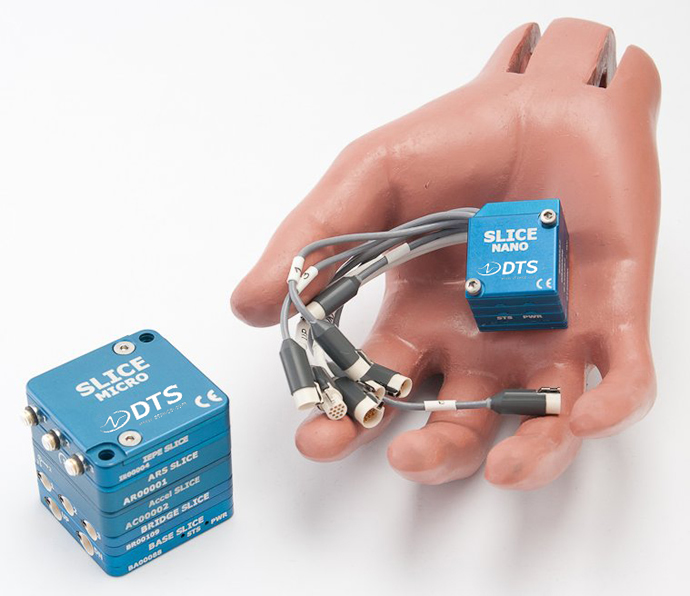The challenge of capturing real world data
All mechanical systems in the real world experience some level of shock and vibration and these forces can take their toll on products (and people). Therefore, design engineers have always had a driving interest in finding ways to better understand our world in motion. California-based Diversified Technical Systems (DTS) look into the technology that is available in order to do this.
Capturing data in-situ, in real world applications, continues to pose several challenges for test engineers. While laboratory testing and simulation provides critical and necessary information, the value of field data can’t be overlooked
However, capturing field data without disturbing test dynamics can be tricky, especially when test articles are small, in motion, or both. Finding a way to reduce vibrational chatter on downhill skis for example, may mean the difference between a gold or silver medal, but instrumenting a skier flying down an icy slope at 128kph is an entirely different challenge. Connecting strain gauges and accelerometers to a data acquisition system, even one that is actually small enough to fit in a backpack, will certainly bias the data with extra weight, a shift in the centre of gravity, and that’s all assuming the sensor cables aren’t restricting any range of motion. Plus if the article is on a rotating shaft, capturing data without trailing cables or slip rings is something that hasn’t been feasible until recently.
A reality for real time data capture
Diversified Technical Systems in Southern California is a manufacturer of ultra-small, rugged data recorders for ‘must collect’ tests, especially where size and weight are at a premium. DTS’s SLICE NANO data acquisition system has a footprint of 26 x 31mm and weighs only ounces - indeed, the company claim that it is the smallest, high-g data recorder on the market. Manufacturers can now embed these tiny data recorders on everything from drones to drive shafts, or even inside crash test dummies without worrying about altering test parameters.
“People have a hard time believing that these are actually fully autonomous data recorders,” said Hans Hellsund, DTS Director of Sales. “They are so small they usually think they must be sensors.” Everything is built-in including the microprocessor, excitation and full signal conditioning. SLICE NANO also boasts 16GB of flash memory, so collecting even hours of high speed data is not a problem. And that’s without the need for large battery packs or generators. Data is downloaded after the event, either in the field or back in the lab.

“DTS systems are not only making testing possible that wasn’t feasible before, they are also helping improve data quality,” added Hellsund. “By being able to position the recorder near the sensors and area of interest, it reduces the need for long, often complicated cable runs that can cause unintended issues such as under powering the transducers, signal drop between the transducer and the data acquisition system, noise from cable motion and even electrical interference. It also eliminates potential issues with cables getting tangled or restricting movement.”
Another common obstacle in this type of testing is environmental factors. DTS systems are engineered to perform in extreme temperatures, high altitudes and high shock environments (500g is the standard shock rating, but there’s an option for a 5,000g model and SLICE HG which is survivable to 20,000g). Surviving impacts is one thing, but capturing the action which may be over in nanoseconds, is another. SLICE NANO samples up to 500,000 data points per second, while its SLICE PRO counterpart can perform one million samples, so getting high fidelity data is never an issue.
These dynamic or even explosive tests may also mean the difference in saving a life. When it comes to validating US Army mine resistant ambush protected (MRAP) troop vehicles, a DTS system can be caged on top of the vehicle during the blast test. It’s also that same human factor that has engineers at NASA’s Langley Research Center in Hampton, Virginia, devoting years to testing the Orion spacecraft in efforts to ensure the crew’s safe return from future deep space missions.
In the next phase of testing, a mock Orion capsule will be wired up with over 500 channels of DTS data recorders, launched atop the Space Launch System (SLS) rocket, and travel more than 40,000 miles beyond the moon to finally return to Earth at speeds up to 25,000mph. Although there are currently no astronauts on onboard, two test dummies will ride along collecting critical data. “We are excited about this testing because we’ll have suited-up test dummies inside the capsule,” said Ellen Carpenter, Langley Project Manager. “Including test dummies will help NASA ensure the crew is protected from injury during splashdown in future missions.”


